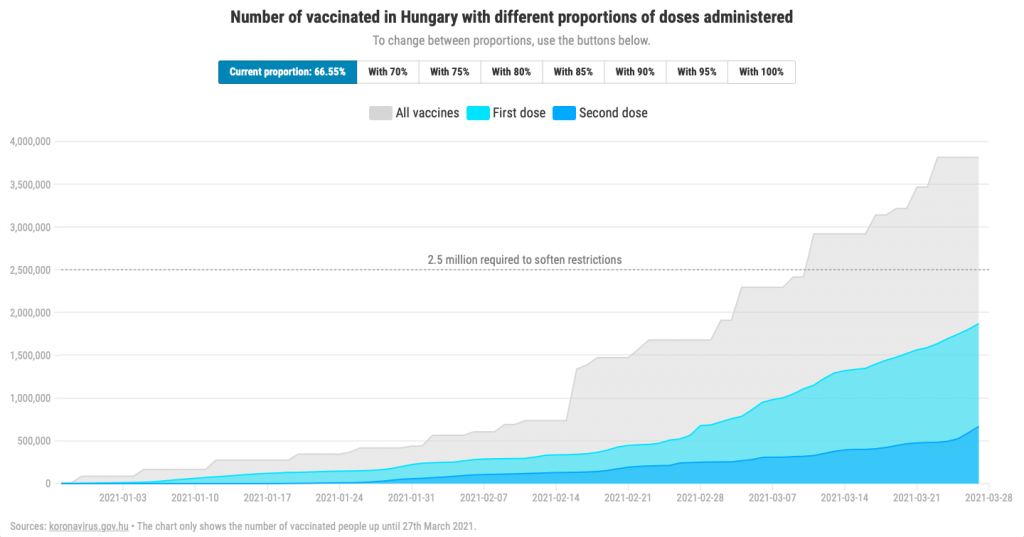The https://english.atlatszo.hu use cookies to track and profile customers such as action tags and pixel tracking on our website to assist our marketing. On our website we use technical, analytical, marketing and preference cookies. These are necessary for our site to work properly and to give us inforamation about how our site is used. See Cookies Policy
With twice as many vaccines delivered, Hungary has no significant lead in ratio of vaccinated compared to other EU countries
As part of the vaccination campaign, the Hungarian government emphasizes the following message: compared to other EU countries, Hungary is in second place regarding the percentage of inoculated population; this couldn’t have happened without the help of Eastern vaccines, since Western shipments are slow and bring only small amounts. Rightfully, Hungary really is second in the uptake of the first dose, and it is partially because of Eastern vaccines. However, comparing the countries by distributed doses, each member state received relatively the same amount from the EU, Hungary being one of the better off countries on the list. Moreover, Eastern vaccines require inspection before usage, which can last for weeks, slowing down the vaccination. Hungary uses these vaccines to compensate low efficiency and organizational issues of its vaccination process, and not to be an addition to Western ones. If it were otherwise, Hungary would by far be the first on the inoculation list and wouldn’t lag behind in terms of administered doses.

In the communication of the Hungarian government regarding vaccination, currently there are three major messages. First, an emphasis of a successful government: among member states, vaccination of the Hungarian population is one of the best. Second, this could have only been achieved because the government was quick to realize the need for other vaccines and ordered from Eastern sources in time. Finally, this success with the Eastern vaccines is now used as a response to the unpredictability of Western shipments, since they are allegedly slow and bring only small amounts each time. “Brussels messed up the orders of vaccines, and if Hungary hadn’t ordered doses from Eastern sources, we would be in great trouble now.” – said Prime Minister Viktor Orbán about the vaccination standpoint of the Hungarian government on 14th March 2021 on the morning broadcast of Radio Kossuth.
All three parts of the Prime Minister’s statement can be refuted.
For this, we must take a closer look on these three components, that make up the vaccination message.
“Brussels messed up the orders of vaccines”
The pandemic website of the Hungarian government – which is by far the least functional in the region – only discloses the daily Hungarian numbers of the pandemic. This is done each morning in a template post containing the relevant data in text form. Moreover, the readers receive weekly-biweekly updates on the number of distributed vaccines to the country, in table form.
Even if these Hungarian data have issues and uncertainties, they can still be found somehow. The same cannot be said about international data or comparisons of international tendencies, though. Regarding the international situation, on the government’s pandemic website one can only find a short post published each morning, where the cumulative number of infected, dead and recovered can be read, broken down into a handful of countries.
There is no daily, international comparison regarding vaccination on the website.
In order to see the full picture, and understand where Hungary is situated compared to other countries in relation to vaccination – or any other aspects of the virus –, we must turn to international databases, of which there are plenty. For comprehensive analysis, we suggest the databases of Our World in Data and European Centre of Disease Prevention and Control (ECDC).
ECDC publishes a weekly report about EU vaccinations. From the latest report of 2021 week 11, which contains data up until 25th March 2021, we can deduct that there were twice as many vaccines relative to inhabitants in Hungary than in any other EU member states.
Vaccine doses distributed to EU countries per 100,000 inhabitants
If we only inspect the vaccines distributed by the EU, then it becomes clear that Hungary received relatively the same amount of doses than most of the other member states. Thus we can say that Brussels did not “mess up” the orders of the member states. On the contrary, Hungary is on the top segment of the list even without a sufficient amount of Moderna vaccines, that were not ordered as the government “found them too expensive”.
EU vaccine doses distributed to EU countries per 100,000 thousand inhabitants
“if Hungary hadn’t ordered doses from Eastern sources”
If we consider that the Hungarian government seeks other sources of vaccines in order to accelerate the vaccination plan and by that to reach herd immunity sooner (or at least 2.5 million that is required to start lifting restrictions), the Eastern contracts could even be acceptable. However, one of the disadvantages of these vaccines is that they have to be inspected by the National Public Heath Center (NPHC).
On the press conference of the Operative Body Concerning the Protection Against the Coronavirus Pandemic held on 18th March 2021, Gergely Gulyás mentioned that this inspection by the NPHC can last for a few days. This was never the case, however, as the duration of the inspection was always at least a week. The exact dates can be deducted from vaccine update posts (like this one), where the date of first use is also mentioned. So far, there were six Russian and three Chinese shipments of vaccines arriving to Hungary. The date of arrival, approval and first use can be seen on the chart below.
Date of arrival, approval and first use of Eastern vaccines
Not only there are 630,000 doses of vaccines within the country that are still under inspection and cannot be administered for vaccination, but the whole procedure can also take weeks, from arrival to first use. The first Russian shipment of 6,000 vaccines took the longest time to approve, as it arrived on 30th December 2020 and was only delivered to a vaccination point on 11th February 2021.
Even without the yet-to-be-approved doses, Hungary still has way more vaccines relative to population than the other EU member states. As for the uptake of first dose vaccines, Hungary takes second place on the list, partially because of Eastern vaccines.
EU rankings, Only approved vaccines//Uptake of first dose (%)
If we only compare the doses administered by the EU, Hungary is not in a bad position, either. However, on the list of uptake of first doses from EU-administered vaccines, Hungary stands as one of the worst in the Union.
Only EU vaccines//Uptake of EU first dose (%)
From the fact that Hungary is one of the worst in the first dose uptake from EU-administered vaccines, we can deduct two things: firstly, the vaccination process in Hungary must have issues compared to most of the member states receiving almost the same amount of doses. Secondly, Hungary partially uses Eastern vaccines to compensate and cover the issues of its vaccination plan. If it were otherwise, Hungary would by far be the first on the inoculation list.
The second refutal is as follows: it matters less that Hungary was quick to order from Eastern sources, since the number of inoculated people did not grow remarkably, while with twice as many available vaccines, Hungary should have become by far number one on the inoculation list already.
This conclusion remains valid not only when we look at inoculated first doses but also while regarding the total number of administered vaccines.
“we would be in great trouble now”
Viktor Orbán stating that the Eastern vaccine saved the vaccination plan can be accepted as truth on its own terms. If Hungary didn’t have any Eastern supplies, then we could not have vaccinated half as much people, as the vaccination plan is slow and has many problems. There is “trouble”, nonetheless, if we take a look at the proportion of vaccines administered.
From the 3,813,435 distributed doses, 3,183,435 doses are already approved. Up until 27th March 2021, 2,537,934 doses were administered as either first or second dose. From these numbers we can calculate that only 79.72 percent of usable doses were administered. From this viewpoint, Hungary is lagging behind most of the member states, even administering less doses than the EU average.
Proportions of vaccines administered in EU member states
The other “trouble” comes from this percentage. If Hungary vaccinated their citizens slightly better in the past few months, the country would have already reached the 2.5 million inoculated people required for easing the restrictions. On the chart below we visualized the number of people vaccinated with various administering proportions. The base value (66.55%) can be reached if we consider all distributed vaccines, not just the ones approved by the NPHC.
From the calculations, we can see that with 90% efficiency, the 2.5 million goal could have been reached by 27th March 2021, and by using all the available vaccines, there would have already been 2.8 million vaccinated people. Given that there are 3.3 million people who registered for vaccination, it would not have been an unrealistic goal to reach.
Number of vaccinated in Hungary with different proportions of doses administered
Vaccination – just as the number of deaths – is one of the most critical aspect in the current wave of the pandemic. The first goal is to reach 2.5 million to be able to start lifting regulations. But the final goal is to reach total herd immunity. To reach this goal even faster, Hungary will be able to use 6.8 million double-dosed and 1.2 million single-dosed vaccines coming from the EU in Q2 2021, according to Katalin Cseh, MEP from the Hungarian party Momentum.
The Hungarian Medical Chamber (HMC) firmly supports the vaccination against the coronavirus. According to them, there is no alternative to mass vaccination. They also emphasize that the speed of acquiring vaccines from alternative sources must not come ahead of professionalism and safety. Nevertheless, as most of the questions concerning alternative vaccines received promising responses, the HMC explicitly asserts and stands by its pro-vaccine standpoint.
Follow the Hungarian coronavirus pandemic illustrated with charts and maps on our Coronamonitor website:
Coronamonitor: we publish daily stats and visualisations on the virus outbreak in Hungary
Data journalism section Atlo of Atlatszo launched a subpage dedicated to daily statistical updates, graphs and maps of the current status of the coronavirus outbreak in Hungary.
Translated by Krisztián Szabó. The original, Hungarian version of this article was written by Krisztián Szabó.
International data is from the weekly-updated database of ECDC. The article uses data up until 2021 week 11. The original article was published on 29th March 2021, and uses data until 27th March 2021.


